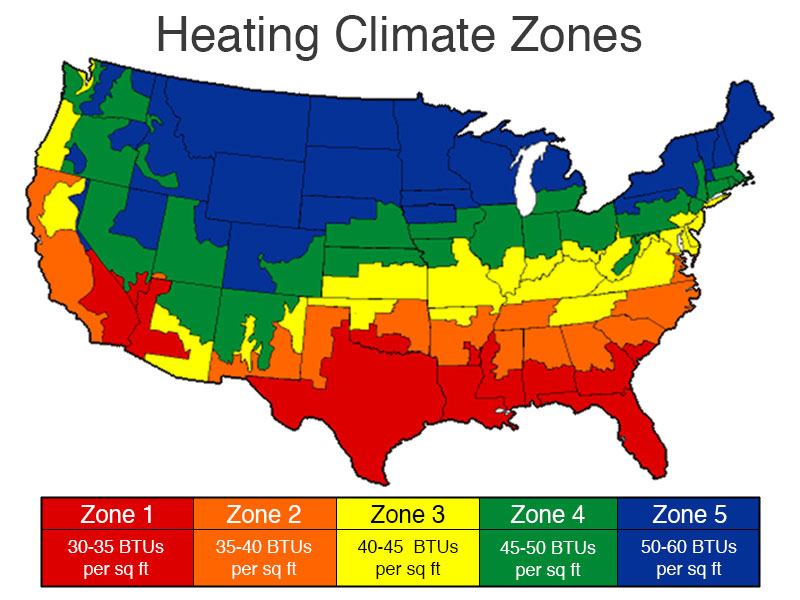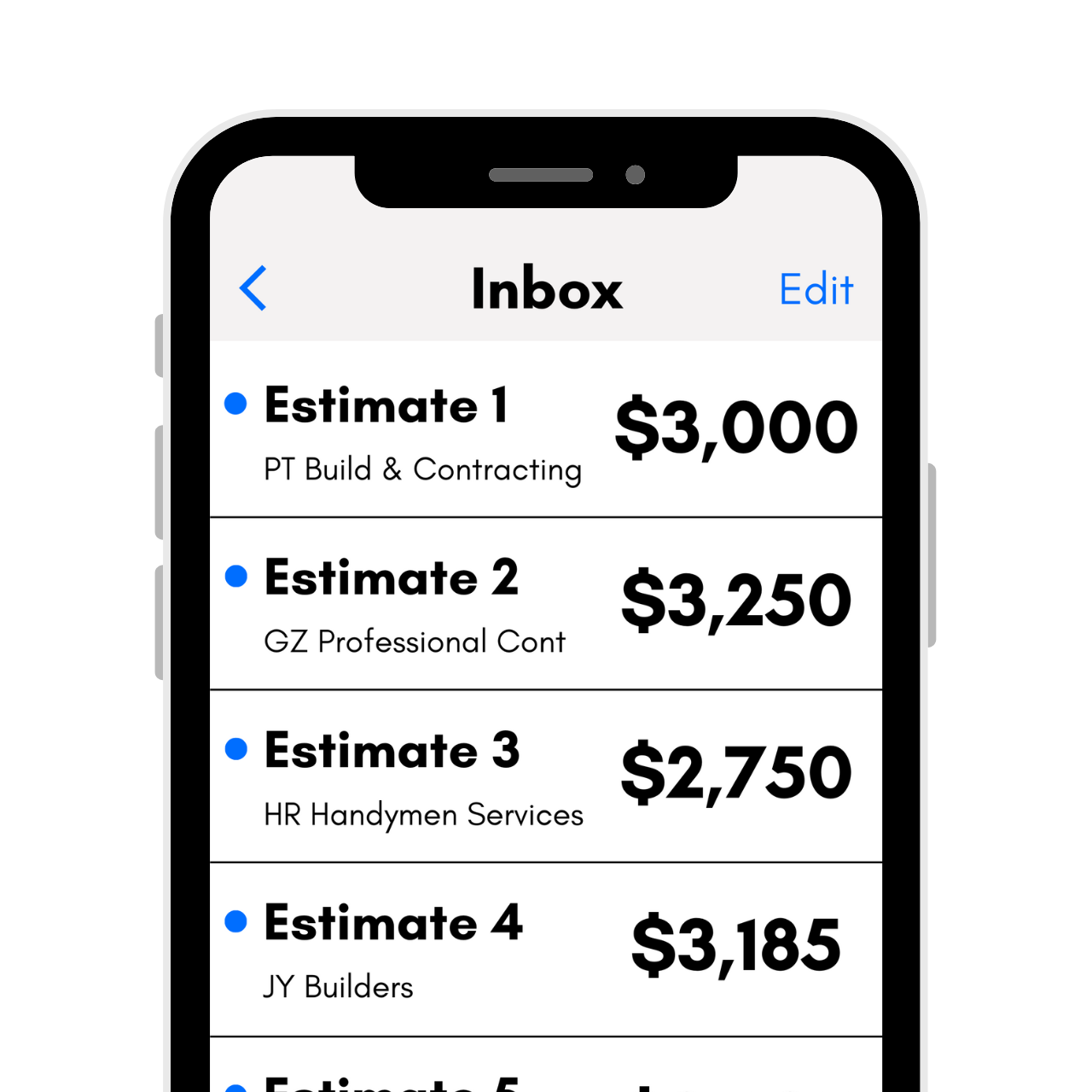Furnace BTU Calculator
Locate your climate zone on the map above and provide your square footage and use the calculator to find how many BTUs your heating system should have.

BTU Estimate:
Recommended BTUs
Climate Zone BTU Range
On this page:
What Are BTUs
A British Thermal Unit, or BTU, is a unit of measurement of energy. 1 BTU is the energy needed to heat 1 pound of water by 1° Fahrenheit. We often refer to the British Thermal Unit as a BTU, but the rating used for heat measurement or furnace size is actually the BTUs per hour, or BTU/h. 1 BTU is the equivalent of 1,055 joules or 0.293 watts.
BTUs are the measurement given for furnace sizes. The more BTUs a furnace produces, the larger the space that it is capable of heating. BTUs can be influenced by the size of a home, its climate, and how well-insulated the building is.
How to Calculate Furnace Size in BTUs
It is very important to size your heating and cooling system correctly for your home. If a furnace or air conditioner is too small, it will run constantly and not be able to comfortably heat or cool the space.
On the coldest or hottest days, the system will not be able to keep up. Alternatively, if the system is sized too large, it will heat or cool the space too quickly, which will cause it to cycle on and off more frequently, causing unnecessary wear and shortening the lifespan of the system.
According to the Star Tribune, the constant cycling of an oversized furnace is less comfortable as well since certain areas of the home heat up too quickly and become too hot before the system turns off.[1] Both furnaces that are too small and too large will also cost you more to run, while still leaving your home uncomfortable. They’ll also wear out faster, costing you more in replacement costs.
There are several factors to consider when trying to figure out how many BTUs your furnace should output.
BTUs per Square Foot Based on Climate
Experts suggest between 30 and 60 BTUs of heat per square foot of living space, which is a pretty wide range.
The location of your home is a major factor in how many BTUs you’ll need. A home in the northern region of the US will require more BTUs to heat than a home in the southern region because it gets significantly colder in the north.
The table below shows how many BTUs per square foot you’ll need based on your climate zone.
| Climate Zone | BTU per Square Foot |
|---|---|
| Zones 1 (hot) | 30-35 BTU/sq. ft. |
| Zone 2 (warm) | 35-40 BTU/sq. ft. |
| Zone 3 (moderate) | 40-45 BTU/sq. ft. |
| Zone 4 (cool) | 45-50 BTU/sq. ft. |
| Zone 5 (cold) | 50-60 BTU/sq. ft. |
Based on these figures, a 2,000 sq. ft. home in a moderate climate would need a furnace with an output between 80,000 and 90,000 BTUs. When making your calculations, you may need to round up or down to the nearest furnace size. Keep things like insulation, sunlight, and the height of your ceilings in mind when choosing whether to go with a smaller or larger furnace.
Home Insulation Affects BTU Requirements
The ranges in the heating climate zone chart above assume a home with average insulation. Homes that are poorly insulated may require 10% more BTUs due to heat loss through thermal transfer.
Very well-insulated homes and homes with a tight building envelope will require 10% fewer BTUs to heat since very little heat is lost. It may be worth adding insulation to attic spaces and walls to reduce the amount of energy needed to heat the home.
An energy audit can help you determine if this is necessary, or if you have other areas of thermal transfer that can be eliminated to help lower your heating bills.
Furnace Efficiency Affects Heat Output
Furnaces are rated on their BTUs of energy consumption, not their BTUs of energy output. A more efficient furnace will output more BTUs of heat than a less efficient furnace with the same BTU rating.
For example, if a furnace is rated at 100,000 BTUs and is 80% efficient, then the heat output will be 80,000 BTUs (100,000 × .8). However, if a furnace is rated at 100,000 BTUs and is 92% efficient, then the heat output will be 92,000 BTUs (100,000 × .92). It may be worth considering a more efficient furnace as less energy will be used to achieve the same heat output.
Keep in mind that electric furnaces will use nearly 100% of the energy they receive to produce heat. Natural gas furnaces can convert up to 98% of energy into heat, while oil furnaces are generally less efficient, with the highest efficiency reaching around 92%.
The higher the efficiency, the less energy you will need to heat your home and the lower your energy bills. Most high-efficiency furnaces are more expensive to purchase, so they may not be worth the savings in hot or warm climates, but they may be worth the investment in cold climates.
While electric furnaces do convert nearly 100% of energy into heat, the cost of electricity frequently makes them costly to run. Therefore, most electric furnaces don’t come in sizes large enough to heat the entirety of a home in colder climates.

Use a Smart Thermostat
Smart thermostats can also improve the efficiency of your heating and cooling system. They can work in different ways depending on the type. Some work by learning when you’re at home and when you’re away. These thermostats can turn down the heat while you’re typically away and turn it up prior to your normal arrival. By learning your behavior, these thermostats can save you money.
Other types will pair with your smartphone or another device. When you leave a designated area, such as outside of your neighborhood, this will indicate to the thermostat to lower the heat. When you reenter this area, the thermostat will raise the heat level again.
Most smart thermostats also allow you to control your heating and cooling from your smartphone. This can allow you to make changes even when you’re at work if you want to turn the heat on for a guest or if your schedule changes and the thermostat hasn’t had time to learn your new schedule.
A popularly used option is the Nest thermostat, but there are several other great smart thermostats on the market.
As an Amazon Associate, we may earn commissions from qualifying purchases from Amazon. Learn more
Consider a Detailed Analysis
Professional heating and cooling installers can provide a much more detailed analysis of your home to select the correct furnace and air conditioning size, tailored to your needs. Consider getting a free heating and cooling estimate for your home.
Professional installers will consider your home’s insulation, door and window sizes and locations, ceiling heights, duct sizes, and other constraints that affect the choice of system. This is called the Manual J calculation. It takes into account all of these factors, as well as how many people live in the home.
The Manual J calculation can give a very accurate size for furnaces and BTUs, so if you think your current furnace may be the wrong size, consider having a professional size your home before making your next purchase. Learn more about the cost of the average furnace installation.
If you’re sizing a cooling system, check out our window air conditioner size calculator to help determine what size air conditioner you will need. If you’re charging a cooling system, check out our refrigerant line charge calculator.
References
- Star Tribune, Problems with Over-sized Furnaces, https://www.startribune.com/problems-with-over-sized-furnaces/229071341/



